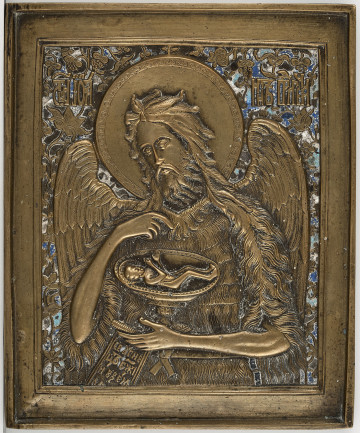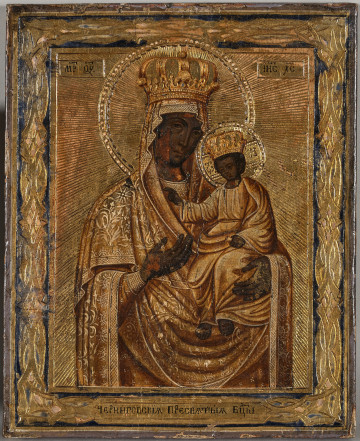
St. John the Baptist
20th century
Castle Museum in Łańcut
Part of the collection: Icons
The displayed icon of the Mother of God and Christ Salvation of the Lost was decorated with a gilded wooden covering, enclosed in an openwork frame, and placed in a wooden kiot with glass walls. The source of this portrayal, widespread in Russia since the 18th c., was a text written down in the east of Christianity in the 7th c. The story "The Repentance of Theophilus the Church Treasurer in the City of Aden" concerned a servant of a bishop's house, who was unjustly defamed and dismissed; feeling ill-treated, he blasphemed against God and made a deal with the Devil. Having come to his senses, he repented for his sin, praying before an unidentified icon of the Mother of God, who gave the contract he signed with the Devil back to him together with a promise of absolution. In this story, known in Russian Orthodox Church since the 17th c., the Mother of God was called the Salvation of the Lost for the first time. The Russian original of the icon is associated with the story of Theodore Obukhov being saved from freezing to death. Returning from a journey home on the day of the Baptism of Christ, he got lost in a blizzard. Realising his hopeless situation, he released his horses, lay down on the sleigh and, directing his thoughts to the Mother of God, vowed to commission an icon in return for having his life saved. The traveller was found by a man, who was led out of his house by the voice of the Mother of God. The rescued Theodore kept his promise and commissioned an icon of the Mother of God for the church in his native village of Bór; it was to be a copy of the 1707 icon housed in the Church of St. George in Volkhov. Since then, both depictions became famous for miracles, and their feast day was decreed to be the 18th of February (5th of February in the Julian calendar). Icons of the Mother of God known as Salvation of the Lost, in reference to people with no hope of rescue, spread in diverse variants. The baby can appear on both left and right side of the painting and the figures do not always touch cheeks; on some depictions, the Mother of God has her head uncovered, with hair falling onto her arms; she can also be standing or seated, with Jesus standing on her lap. Teresa Bagińska-Żurawska https://orcid.org/0000-0002-9243-3967
Other names
Saving the Lost
Dimensions
height: 15.3 cm, width: 13.5 cm
Object type
Icons
Technique
gilding, tempera, woodcarver
Material
gold, tempera, wood
Creation time / dating
Creation / finding place
Owner
Castle Museum in Łańcut
Identification number
Location / status

20th century
Castle Museum in Łańcut

19th (?) century
Castle Museum in Łańcut

1800 — 1850
Castle Museum in Łańcut
DISCOVER this TOPIC
National Museum in Lublin
DISCOVER this PATH
Educational path